|
Some Kentish Gravestones
& other notes
Monuments
in St
John the Divine Church, Chatham
with Index
of names
I am most grateful to the
Reverend Martyn Saunders for giving me access to the gallery to enable
me to transcribe the Day monument. I also thank Ted Connell for hosting
this brief article and for compiling an index. I am grateful for the
help of the staff at Medway Archives, Strood.
The church which was built in 1821-22, was designed by Sir
Robert Smirke, the architect of the British Museum. The site was rather
constricted and the orientation is more north-south than the usual one.
The building, of Ragstone, with Portland Stone details, has a plain,
heavy appearance, but the interior is light and spacious.
When the church was built, the original parish church, St
Mary the Virgin, (now no longer used as an Anglican church) was the
busiest parish church in the county, the population was still
concentrated in the centre of the town, so a new church was need to
relieve the pressure.
In 1843 Christchurch was established at Luton, the eastern
part of Chatham, which was growing rapidly and in 1853 another church,
St Paul's (now demolished) was built on the New Road, to the east of St
John's.
The church had no space for it's own burials, in fact, it
had no registers until the 1850's, so the monuments are cenotaphs. David
Day and George White were buried at St Mary's, George Viney at Chatham
Cemetery as was Matthew Stephens, I do not know where Elizabeth Laycock
is buried. .
For the last quarter century the church has been empty and
disused but now it is once again a living church and it seems likely
that the commitment of the Reverend Saunders and his team will ensure
it's future as the only functioning Anglican church in central Chatham.
D. E. Williams, Borstal, Rochester 15th June 2022
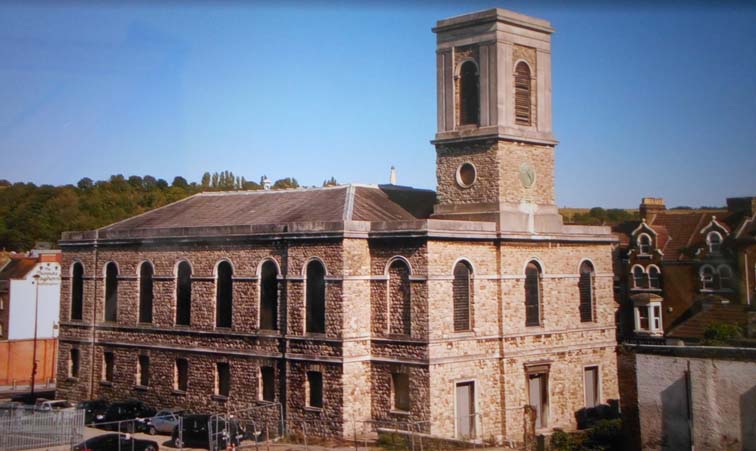 |
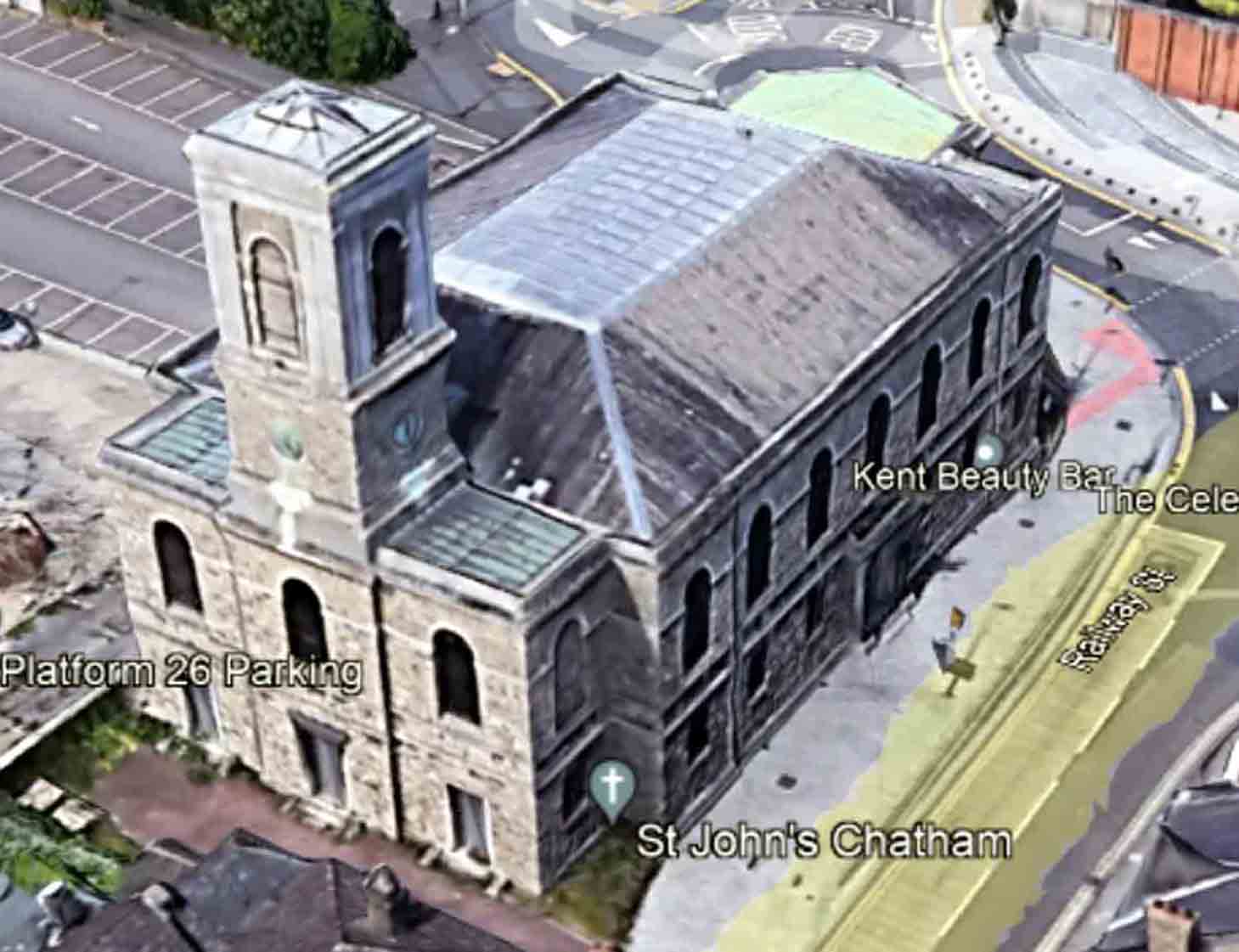 |
|
St. John's Church from the North
- West. This view clearly
shows the constricted space available for the building
|
©
Google Earth - St. John's Church from the South
- West. This view clearly
shows the constricted space available for the building |
1. Marble
Tablet high on the "North East" wall of the Nave,
Depicting a Mourning Woman contemplating an Urn,
with two inverted
Torches beneath the inscription.
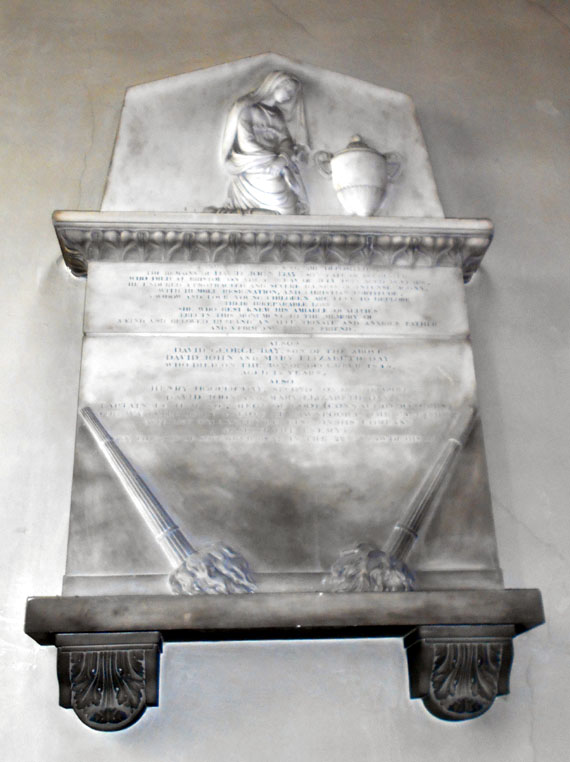
David John DAY 1839
IN A VAULT NEAR THIS SPOT
ARE DEPOSITED
THE REMAINS OF DAVID JOHN DAY ESQ. LATE
OF ROCHESTER
WHO DIED AT BRISTOL ON THE 17th DAY OF JULY 1839 AGED 38
YEARS
HE ENDURED A PROTRACTED AND SEVERE ILLNESS OF INTENSE
AGONY
WITH HUMBLE RESIGNATION AND CHRISTIAN FORTITUDE
A WIDOW AND FOUR YOUNG CHILDREN ARE LEFT TO DEPLORE
THEIR IRREPLACEABLE LOSS
SHE WHO BEST KNEW HIS AMIABLE QUALITIES
ERECTS THIS MONUMENT TO THE MEMORY OF
A KIND AND BELOVED HUSBAND AN AFFECTIONATE AND ANXIOUS
FATHER
AND A FIRM AND SINCERE FRIEND
ALSO
GEORGE DAVID DAY SON OF THE ABOVE
DAVID JOHN AND MARY ELIZABETH DAY
DIED THE 30th OF DECEMBER 1845
AGED 14 YEARS
ALSO
HENRY HOOPER DAY SECOND SON OF THE
ABOVE
DAVID JOHN AND MARY ELIZABETH DAY
CAPTAIN IN H. M. 88th REGT OF FOOT (CONNAUGHT RANGERS)
WHO WAS KILLED IN ACTION AT CAWNPORE IN THE EAST INDIES
WHILST GALLANTLY LEADING HIS COMPANY
AGAINST THE ENEMY
ON THE 27th OF NOVEMBER 1857 IN THE 22nd YEAR OF HIS AGE
It seems clear, from the
wording of this inscription, that David Day was buried
inside St Mary's church and that the monument was once in
that church but although the wording strongly suggests it
was intended for St Mary's, it is not certain that it ever
was erected there ?
At the time of writing, I do not know why and
when it was removed to St John's, I also do not know why Day
was buried at St Mary's, had he lately moved to Chatham ? I
also do not know why he was in Bristol when he died, it
seems odd that he was travelling when suffering from a severe,
protracted illness ?
Summary of a Prerogative
Court of Canterbury Will Dated 21st November 1833
This will is very disappointing, although it consists of
7 pages, it gives no details of any real estate and few
details of his personal estate. The bulk of the will is
taken up with details of trust funds for the benefit of his
wife and children.
He is of St Nicholas parish, Rochester, (where
his family were Bankers).
His executors and trustees were his brothers, Thomas
Hermitage Day and Edward Day and
his brother in law, Jacob Bryant, (when he
attains the age of 21). He gives to his wife,
absolutely, all his household furniture, books, pictures,
plate, linen, glass, china, wine and other liquors, horses
and carriages. She is also to receive the rents and
dividends of his estate, while she remains his widow, in
lieu of her Dower rights on his real estate and £300 cash.
Witnesses: Henry Prentis, Solicitor of
Rochester, John Thomas Austin, Clerk to
Mr Prentis, John White, Gardener to Mr Prentis.
Codicil, 27th January 1838
Jacob Bryant has died since the will was made.
He now appoints Jacob George Bryant* of
Chatham, Esquire an executor and trustee in place of Jacob
Bryant. He gives him, for his care and trouble in the
execution of the trusts, £100.
Rest of will confirmed.
Witnesses: John Stone of
Rochester, B. Bentham of Rochester.*
Proved 31st October 1839 Power reserved to Edward
Day
* Jacob George Bryant was a Surgeon and a Justice of the
Peace. B(ryan) Bentham was sometime Manager of
the Day Bank, which, in 1847, as Day and Nicholson
had branches in Chatham and Strood. John Stone,
formerly in the Royal Navy, appears as a Banker in Rochester
High Street, next to the George Inn, in the
1861 Census, aged 61.
Henry Hooper Day was killed during the
Indian Mutiny. Cawnpore was the site of a notorious massacre
of 200 European women and children by the mutineers.
The Times reported that "he was
previously wounded in the arm but refused to retire and
continued gallantly leading his men when he fell shot
through the head."
The location of his death was Pandoo Nuddee.
There is a memorial to him in the Memorial Church at
Cawnpore.
2. Brass
Plaque on the "South Wall", under a Stained Glass
Window
(Probably buried at Chatham Cemetery but no monument
found)

Elizabeth Mary LAYCOCK 1879
TO THE GLORY OF GOD AND IN
LOVING MEMORY OF
ELIZABETH MARY LAYCOCK WHO ENTERED INTO
REST
FEBRUARY THE 19th 1879
1871 Census Elizabeth
Mary Laycock, wife of William Laycock,
Surgeon and Chemist of 14 and 15 Hammond
Place, Chatham. She was then, aged 52.
3. Brass
Plaque on the "South Wall", under a Stained Glass
Window
( Buried at Chatham Cemetery, Section N, no. 272 but no
monument found)
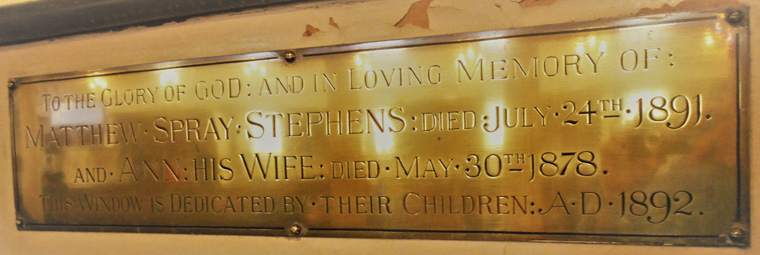
Matthew Spray STEPHENS 1891
TO THE GLORY OF GOD AND IN
LOVING MEMORY OF
MATTHEW SPRAY STEPHENS DIED JULY 24th
1891
AND ANN HIS WIFE DIED MAY 30th 1878
THIS WINDOW IS DEDICATED BY THEIR CHILDREN
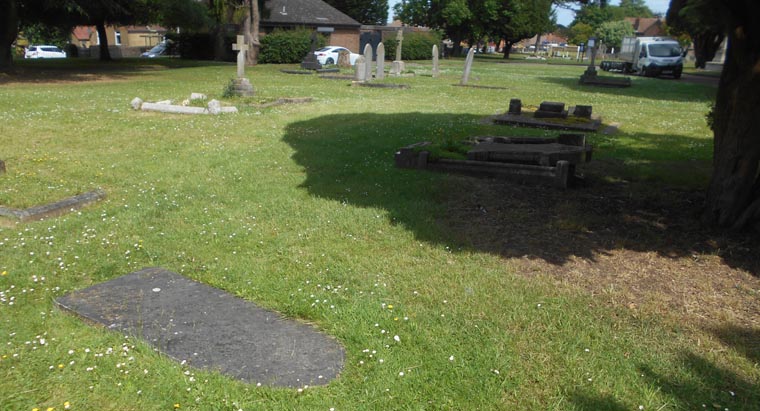
Part of section N, Chatham Cemetery
Part of section N, Chatham Cemetery, where Stephens is
buried. It is mostly
grass with relatively few monuments and no monument for
Stephens can
be found, although the fallen headstone is too heavy to lift
and remains unchecked.
Matthew Stephens
was a solicitor of 19 (later 40) Gibraltar Place or Terrace,
(on New Road). The family law business had been established
by his father, John, early in the 19th century, John
Stephens appears in the 1824 Pigot's Directory
on New Road and John and Matthew Stephens
in the 1838 Pigot's Directory, at 19 Gibraltar Place
Summary of Obituary in the Chatham Observer
Saturday 1st August 1891
Matthew Spray Stephens was a
Solicitor of Gibraltar Terrace and his firm had been
associated with the town for upwards of 90 years.
He was the second son of John Stephens,
Solicitor, born at Gibraltar Terrace in 1798; he died, just
short of his 93rd birthday, having lived all his life in the
house he was born in.
He qualified in 1823 and was still on the profession's rolls
when he died, though not active, he was the head of M.S.
Stephens & Son (A.F.W. Stephens),
his practise spanned 68 years.
He was afflicted with deafness, which probably explains why
he was not very active in public affairs. He did, however,
act as Steward of the Gillingham Court Leet, succeeding his
father, for 40 years, in turn, he was succeeded by his son,
his partner.
He was a non conformist, a member of the Ebenezer
Congregational Church, Chatham.
He was said to be uptight and honourable, living a Christian
life, respected by all who knew him.
Shortly before his death he had recovered from
"congestion of the lungs" but succumbed to
exhaustion due to his advanced age.
He married in middle life, his wife dying 13 years before
him, leaving 3 sons and 5 daughters, M.J.D.
Stephens, Solicitor of Hong Kong, at present living
in St Leonards, A.F.W. Stephens,
Solicitor, for 16 years his father's partner, Surgeon-Major
A.E.R. Stephens of the Indian
Medical Service, his youngest daughter is the widow of the
Rev J.F. Eyre, former Vicar of Ilkestone.
The funeral was on the 31st of July at Chatham Cemetery.
The Chatham News carried an almost identical obituary but
also tells us that Mr Stephens was in the care of Dr J.V.
Bell of Rochester and that his military Surgeon son
was travelling home from India.
H.M. Probate Service Index
Matthew Spray Stephens, Solicitor of 40
Gibraltar Place.
Administration granted to Matthew John Denman
Stephens of 5 Marwick Terrace, St. Leonards, Sussex
and Adolphus Frederick William Stephens
of Rome House*, Chatham, Solicitor, sons and Henrietta
Bertha Stephens of 40 Gibraltar Place,
Spinster, daughter and James Vincent Bell,
of Rochester, M.D., the executors.
Personal estate valued at £3,949 3s 1d, in 20217, the
modern equivalent is about £324,000, although it is
difficult to be accurate due to the large inflation in house
prices. In 1891 £3,949 would buy considerably more in
property than £324,000 would now (National Archives
Calculator)
* This building is part of a terrace of large properties in
Railway Street, opposite St. John's church, which were new
in 1891. Still a Solicitors' practise and still bearing the
name of Stephens and Son.
Summary of the Will Dated 22nd May 1890
Matthew Spray Stephens of Chatham,
Solicitor.
He appoints son, Matthew John Denman Stephens,
daughter, Henrietta Bertha Stephens and
his friend, Dr James Vincent Bell of
Rochester as his "special executors" in respect of
the money his son and partner, Adolphus Frederick
William may owe to his estate or executors.
He appoints sons, Matthew and Adolphus,
daughter Henrietta and Dr James Bell as
executors in respect of his personal estate and as his
trustees.
His debts, funeral and probate costs to be paid as soon as
is convenient.
After this is paid then, he gives to his children, Ann
Spray Stephens, Matthew, Selina Elizabeth
Stephens, Adolphus, Eliza Rebecca
Stephens, Augustus Edward Richard,
Henrietta Bertha Stephens and Alice
Maud Eyre of Dover, Widow, £50 each.
To his nieces, Charlotte Kaye and Joanna
Eike, Widow, £5 each .
To Edward James Harnden, if still in
his employ as Clerk, £10 and to William Kemsley,
if still in his employ as Clerk, £4.
To his male executors who prove his will, £20 each and to Henrietta
Bertha Stephens, if she proves his will £10.
Trustees to spend a sum not exceeding £8, to provide his
sister, Sarah Rachel Stephens,
mourning.
All silver plated articles, (except those in daily use) and
books to his daughters, Ann, Selina, Eliza,
Henrietta and and Alice. If they can not agree
the division within 6 months of his death, his trustees to
make the final decision.
His household goods, furniture, Broadwood piano and music
books, looking glasses, linen, china, prints and drawings,
jewellery and other articles and effects in his house, (
except money, securities for money, and muniments of Title
and things already given to his children), including all
consumables , equally shared between his daughters, Ann,
Selina, Eliza and Henrietta. The
division to be recorded and acknowledged by each of them. As
before, any disagreement to be settled by trustees. Trustees
to have an inventory made of these articles.
By an Indenture dated 28th September 1876, he conveyed his
freehold residence, 40 New Road, Chatham, formerly 20
Gibraltar Place, to the use of himself, for life and
ultimately to such use as his 5 daughters jointly decide.
Trustees to hand original conveyance and Title deeds of the
house to daughter, Henrietta, she entering the usual
legal acknowledgment with each of her sisters, at the cost
of his estate.
By an Indenture of Settlement, dated 15th May 1876, made
between himself and his late wife, Ann of the 1st
part and James V. Bell and Henry
Watts of the other part, he and his wife settled
money, with additional sums made now, totalling £3,000,
upon trust, for his 5 daughters. Trustees to hand duplicate
of Settlement and endorsed deeds to his daughter, Selina,
she entering the usual legal acknowledgment, as above.
To his "special executors", his part of the Deed
of Co-partnership, dated 26th February 1877 between himself
and son Adolphus, relating to the Partnership
Business of Solicitors and all his share and interest, also
any sum, by which the latter is to purchase the testator's
interest.
Also arrears of income to the partnership and his share in
the net balance of the business accounts, upon trust,
trustees to collect the same.
He gives all his messuages, land and real estate, chattels
and residue of personal estate and effects to trustees, upon
trust, to sell and pay his debts, funeral and probate
charges and legacies. And invest the reside in real estate
in England or in Public Funds of great Britain, as such?,
daughter, Selina?, approves in the name of all his
daughters.
To daughters, Ann, Selina, Eliza and Henrietta, £350 each
and to daughter, Alice, £250. He is not giving Alice £350
because he made a considerable advance of cash to her late
husband in his lifetime.
Trustees to invest £300 in their names in Public Funds or
real estate, upon trust , to use the interest and any part
of capital, if necessary, to pay up to £6 5s per quarter
towards the support of his sister, Sarah Rachel.
Witnesses: J. Harnden and William Kemsley,
Clerks to Messrs Matthew Spray Stephens
and Son, Solicitors, Chatham.
Proved 28th September 1891
4. Brass Plaque on the "South
Wall", under a Stained Glass Window
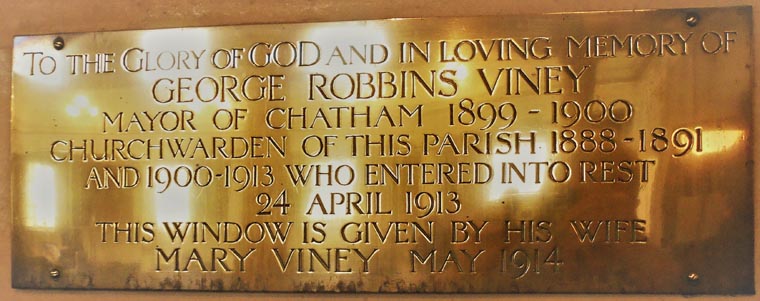
George Robbins VINEY 1913
TO THE GLORY OF GOD AND IN LOVING MEMORY OF
GEORGE ROBBINS VINEY
MAYOR OF CHATHAM 1899-1900
CHURCHWARDEN OF THIS PARISH 1888-1891
AND 1900-1913 WHO ENTERED INTO REST
24th APRIL 1913
THIS WINDOW IS GIVEN BY HIS WIFE
MARY VINEY MAY 1914
4a. Monument in Chatham Cemetery, Section J,
Grey Granite, stepped Ledgers with Horizontal Cross
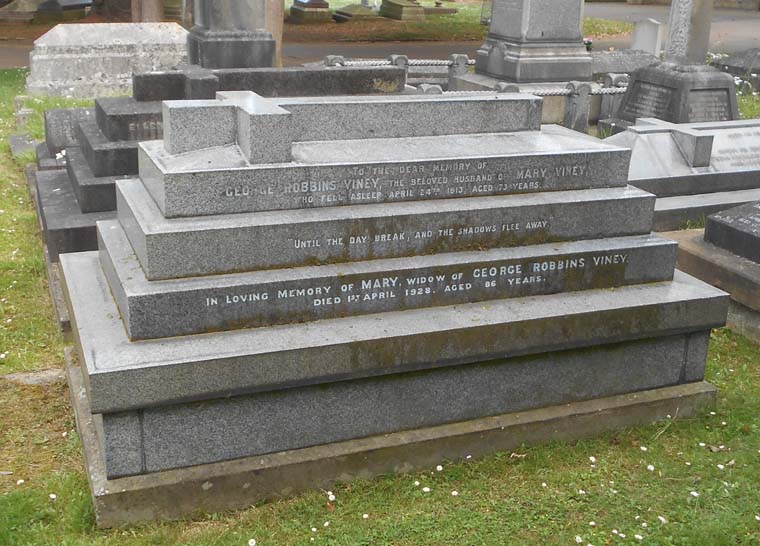
George Robbins VINEY 1913
Viney's tomb in Chatham Cemetery, Section J, beyond it, is
the
tomb of Charles Withecombe, identical but for it's darker
stone
TO THE DEAR MEMORY OF
GEORGE ROBBINS VINEY THE BELOVED
HUSBAND OF MARY VINEY
WHO FELL ASLEEP APRIL 24th 1913 AGED 73 YEARS
"Until the Day Break and the Shadows Flee Away"
IN LOVING MEMORY OF MARY WIDOW OF GEORGE ROBBINS
VINEY
DIED 1st APRIL 1928 AGED 86 YEARS
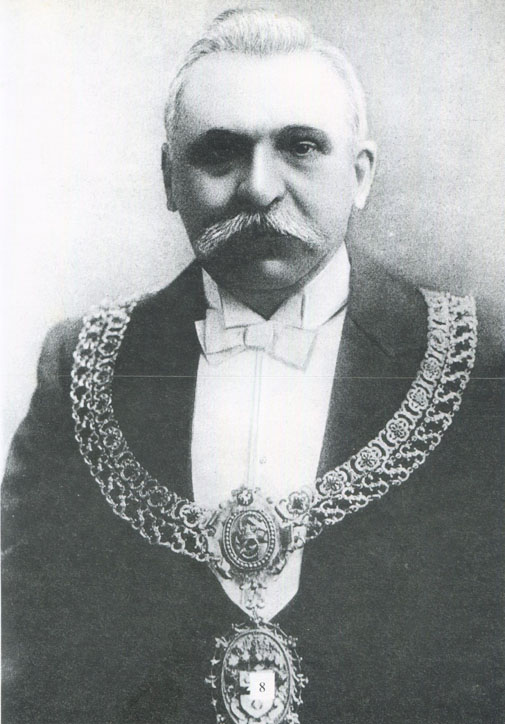
George Robbins VINEY Mayor of
Chatham 1899-1900
Summary of an Obituary from the Chatham Observer
Alderman Viney died from heart failure. He
was born in Rochester and educated at the Mathematical
School of that City.
He was apprenticed to the late Councillor, John Cole
, Pawnbroker and Silversmith of Rochester.
Viney started his own business with George Stevens
in 1865 and retired in 1895.
He was said to be a man of a genial and generous
disposition, "in every way he was fair and straight
forward to everybody and was one of the best type of
citizen".
He was elected to Chatham Town Council for St John's Ward in
1891, elected an Alderman in 1902 and for a further 6 years
in 1908 and was Mayor of Chatham in 1899. During his
Mayoralty the new Town Hall was opened by Lord Roseberry,
(January 1900).
He was involved in the administration of the Poor Law and
was a member of the Board of Guardians, 1892-98 and held
several other public offices. He was also was a Director of
a Water Works Company from 1900.
A strong Conservative, he was Chairman of the Chatham
Constitution Club. He was a churchwarden of St John's church
and was involved in many Friendly Societies, Chairman of the
Chatham Nursing Association, St Bartholomew's Hospital and
other charitable organisations.
He was interested in sports, especially cricket.
He married the eldest daughter of Charles Withecomb.*
He Mayor, William Paine, paid tribute and
spoke of his "genial manner and kindness of
heart".
Alderman Whyman, added, "they all knew that the
kindness of Alderman and Mrs Viney was
proverbial"
George Viney's business was at 213 Chatham
High Street
* The Withecombe family grave is next to Viney's
in Chatham Cemetery, their monuments are almost identical.
Index of H.M. Probate Service
George Robbins Viney of 11 New Road,
Chatham.
Administration granted to Mary Viney, Widow
and Adolphus Frederick William Stephens,
Solicitor .
Effects value, £5,755 11s 11d, re-sworn at £5,798 11s 11d,
in 2017 the modern equivalent is over £453, 000.
5. Marble Tablet on the "South Wall"
George White appears in the Burial
Register of St Mary, Chatham, no monument
found in the churchyard or in the Whiffen's Avenue Burial
Ground
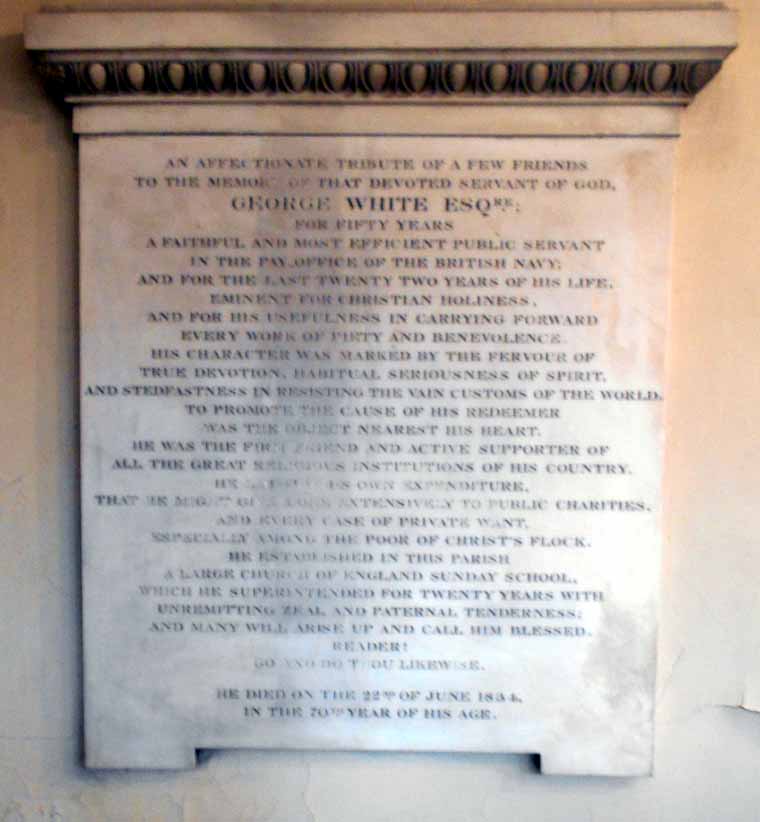
George WHITE 1834
AN AFFECTIONATE TRIBUTE OF A FEW FRIENDS
TO THE MEMORY OF THAT DEVOTED SERVANT OF GOD
GEORGE WHITE ESQ.
FOR FIFTY YEARS
A FAITHFUL AND MOST EFFICIENT PUBLIC SERVANT
IN THE PAY OFFICE OF THE BRITISH NAVY
AND FOR THE LAST TWENTY TWO YEARS OF HIS LIFE
EMINENT FOR CHRISTIAN HOLINESS
AND FOR HIS USEFULNESS IN CARRYING FORWARD
EVERY WORK OF PIETY AND BENEVOLENCE
HIS CHARACTER WAS MARKED BY THE FERVOUR OF
TRUE DEVOTION HABITUAL SERIOUSNESS OF SPIRIT
AND STEADFASTNESS IN RESISTING THE VAIN CUSTOMS OF THE WORLD
TO PROMOTE THE CAUSE OF HIS REDEEMER
WAS THE OBJECT NEAREST HIS HEART
HE WAS THE FIRST FRIEND AND ACTIVE SUPPORTER OF
ALL THE GREAT RELIGIOUS INSTITUTIONS OF HIS COUNTRY
HE LIMITED HIS OWN EXPENDITURE
THAT HE MIGHT GIVE MORE EXTENSIVELY TO PUBLIC CHARITIES
AND EVERY CASE OF PRIVATE WANT
ESPECIALLY AMONG THE POOR OF CHRIST'S FLOCK
HE ESTABLISHED IN THIS PARISH
A LARGE CHURCH OF ENGLAND SUNDAY SCHOOL
WHICH HE SUPERINTENDED FOR TWENTY YEARS WITH
UNREMITTING ZEAL AND PATERNAL TENDERNESS
AND MANY WILL RISE UP AND CALL HIM BLESSED
READER
"GO AND DO YOU LIKEWISE"
HE DIED ON THE 22nd OF JUNE 1834
IN THE 70th YEAR OF HIS AGE
George White, having transferred from London
to Chatham, about 1814, would certainly have known John
Dickens, father of Charles Dickens, who
was a Clerk in the Pay Office in H.M. Dockyard at Chatham.
When St John's was opened by Archdeacon John Law,
a large tent was erected on a nearby field to provide a
feast for the children of White's Sunday School. An
astonishing total of 500 were accommodated, more than
likely, not all the children were actually pupils at the
school!
Summary of a Prerogative Court of Canterbury Will Dated
12th February 1816
Like Day's will this will is very disappointing, it is
very short and contains no real estate details, if any and
very little personal estate details.
George White, Esquire, of the Navy Office,
London, now residing at Chatham.
(White was probably stationed at Somerset House, when in
London)
First, his debts, funeral and probate costs to be paid.
He then bequeaths to his wife, Henrietta, all ready
money, money in the Public Stocks, money due from H. M.
Navy, from bonds, bills, notes or otherwise, household goods
and furniture, plate, linen, and china and all the rest and
residue of his estate and effects, for her own use and
benefit.
He appoints his wife, sole executor.
Witnesses: W.J. Stephens H. Stephens
Proved 16th June 1834
Note in margin, 11th October 1838
The will was not administered by Henrietta White,
(deceased), so administration was granted to Ann Priscilla,
wife of Ebenezer Daldy Hollick, the
daughter.
Index
Names
Austin 1
Bell 3
Bentham 1
Bryant 1
Cole 4a
Daldy 5
DAY 1
Denman 3
|
Eike
3
Eyre 3
Harnden 3
Hermitage 1
Hollick 5
HOOPER 1
Kaye 3
Kemsley 3
Nicholson 1
|
Law
5
LAYCOCK 2
Lord Roseberry 4a
Paine 4a
Prentis 1
ROBBINS 4, 4a
SPRAY 3
STEPHENS 3, 4a, 5
Stone 1 |
VINEY
4, 4a
Watts 3
White 1
WHITE 5
Whyman 4a
Withecomb 4a |
Places
BRISTOL 1
CAWNPORE, EAST INDIES 1
Chatham 1, 4, 5
Gibraltar
Terrace 3
Hammond Place 2
Rome House,
Railway Street 3
St John's Ward 4a
Dover 3
Hong Kong 3
Ilkestone 3
Pandoo Nuddee, India 1
Rochester 1, 3
George Inn
1
Mathematical
School 4a
Marwick Terrace,
St. Leonards, Sussex 3 |
Miscellaneous
Army
Captain 1
88th Regt of Foot,
(Connaught Rangers) 1
Bankers 1
Chatham Constitution Club 4a
Chatham Town Council 4a
Chemist 2
churchwarden 4, 4a
Clerk 1
Ebenezer Congregational
Church, Chatham 3
Gardener 1
Indian Medical Service 3
Justice of the Peace 1
|
M.D. 3
MAYOR 4
Navy Office, London 5
Pawnbroker 4a
Pay Office in H.M. Dockyard 5
PAY OFFICE OF THE BRITISH NAVY 5
Poor Law 4a
Royal Navy 1
Silversmith 4a
Solicitor 1, 3
Stephens & Son (A.F.W. Stephens) 3
Steward of the Gillingham Court Leet 3
Surgeon 1, 2
Surgeon -Major 3
The Day Bank 1
Water Works Company 4a
|
Back to Kentish Gravestones
& other notes introduction
This website is constructed
by enthusiastic amateurs. Any errors noticed by other researchers will be gratefully received
so that we can amend our pages to give as accurate a record as
possible. Please send details to localhistory@tedconnell.org.uk
|









